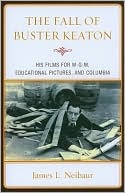| James L. Neibaur, The Fall of Buster Keaton: His Films for M-G-M, Educational Pictures, and Columbia Lanham: The Scarecrow Press, 2010 ISBN-13: 978-0810876828 US$45.00 (pb) 225pp |
 |
Neibaur’s The Fall of Buster Keaton concentrates on films which have been dismissed or glossed over in other works on Keaton, namely the films he made for MGM, Educational Pictures and Columbia Pictures. This neglect seems partially caused by Keaton’s own low opinion of his work between 1928 and 1941 as well as the unavailability of most of these films until quite recently. Neibaur’s re-evaluation of these films concludes that some are not as bad as later critics and Keaton himself thought. In spite of the title of this book, it covers not just the three periods mentioned but the intervening years and much of Keaton’s sound career after his time at Columbia, including appearances in film and on television, as well as industrial films, the ‘beach party’ films and his final film appearances.
The book approaches each film as a separate text, in this case beginning each film on a new page. This segmentation of the book feels unnecessary – there is linking material at the end of each film section which, when laid out as a straight narrative, would have made a far more readable book. In any case, the writing style throughout is quite informal and chatty. This is not a bad thing when appealing to new readers, however the niche subject matter lends itself more to people already familiar with Keaton’s work and looking for more detailed information.
The book opens with a short introduction and Chapter One which summarise Keaton’s early life in vaudeville, his transition to film and his silent film career. The introduction to Chapter Two describes how Keaton moved from independent production to MGM. It is extremely short which seems inadequate given that this is the meat of the book. It also does not give much background detail on Joseph Schenck’s decision to sell Keaton’s contract, nor Keaton’s reaction. The chapter itself discusses the English language versions of Keaton’s MGM films in detail. Chapter Three describes Keaton’s aborted attempt at independent production following his sacking from MGM – a film entitled The Fisherman at a small, Florida-based studio. Chapter Four returns to the film-by-film style, covering the sixteen short films Keaton made for Educational Pictures between 1934 and 1937, again in great detail. In Chapter Five, Neibaur charts Keaton’s second stint at MGM, as a gag writer following his years at Educational Pictures. He then moves on to his period at Columbia from 1939 to 1941 in Chapter Six. The final part of the book is devoted to Keaton’s film and television work after Columbia, between 1941 and his death in 1966, including film cameos, his television series and industrial films. Neibaur rounds off his book by discussing The Railrodder (Canada 1965) and the accompanying documentary Buster Keaton Rides Again (Canada 1965).
Despite coming from an academic publisher, the book is more journalistic than academic. The text is minimally referenced which can sometimes create the impression that Neibaur is writing opinion rather than fact. However his plot summaries are very accurate and as such, the book is a useful resource for people unfamiliar with the work Keaton did in this period. That said, Neibaur’s book is by no means perfect. Parts of the introduction covering Keaton’s early stage and film career are condensed to the point of inaccuracy. This section on Keaton’s film debut is a perfect example:
Having an instinct for timing and a long experience with pratfalls, Buster turned around just as the flour sack was about to come in contact, took the hit, lifted his feet high in the air, and did a solid fall. (2)
Neibaur’s account of this incident leaves out one key fact: by Keaton’s own account, he turned when Roscoe Arbuckle shouted “Turn!” (Keaton and Samuels, My Wonderful World Of Slapstick, 92) and it does not detract from Keaton’s performance of the stunt to say so.
Neibaur’s discussion of The Cameraman (USA 1928) suggests that the climactic Tong War sequence “is perhaps the best example of how M-G-M’s budgets could allow for sequences on a grander scale” and is “much larger in scope than independent production would likely have allowed” (16). He also refers to the number of extras and camera angles used in the scene as evidence of this “grander scale”. It is surprising that anyone could contrast Keaton’s dynamic body and the breadth and depth of shots in his independent films with the crowded, fast-cutting finale of The Cameraman and conclude that MGM allowed Keaton more scope for action.
It is hard to agree with much of his praise of Keaton’s Columbia shorts but Neibaur is determined to rehabilitate them, insisting that Keaton’s comedy “blends” (159) with the anarchic style of director Jules White. He describes previous opinions of them as “dismissive” then cites Keaton’s opinion (“crummy”) and that of Okuda and Watz from The Columbia Comedy Shorts (“the worst films of Keaton’s career”) (137). However, between these he includes Dorothy Appleby’s account of Keaton sitting and crying between takes. Whether or not these opinions are intended to relate to the word “dismissive” is unclear. The other two opinions arguably are dismissive, which makes the inclusion of Appleby’s account in this context seem very odd. Neibaur also fails to adequately discuss the history of the relationship between Keaton and White, who co-directed Keaton’s 1931 MGM feature Sidewalks of New York with Zion Myers and which Keaton considered his worst film of that period.
In spite of these reservations, Neibaur’s book, though flawed, is something to be welcomed. There has been very little written on this subject and this book should be built on to achieve a more rounded critical view of Keaton’s career.
